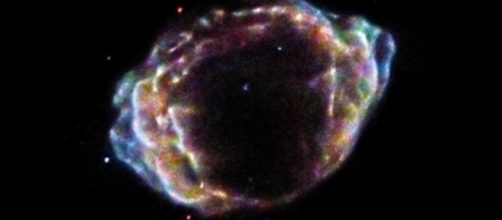Scientists, using technology from NASA's Chandra X-ray Observatory and Jansky Very Large Array (VLA) have resolved the likely cause of the most recent supernova explosion in the Milky Way. They performed a new technique to discriminate between two hypothesized processes of supernova, type 1A Formation -- a type of phenomena that astronomers use for determining the rate of expansion of the universe.
Type 1A supernova
This type of supernova develops in binary systems of stars, where one of the stars is a white dwarf; the other star may be a giant star or another white dwarf.
These stellar bodies produce uniform luminosity due to the identical mass white dwarfs have during supernovae explosions. This characteristic makes them useful for astronomers as markers to measure the acceleration and expansion of the universe.
G1.9+0.3 supernova remnant (SNR)
This SNR was first identified in 1984 with the VLA and is the youngest remnant of the most recent supernova explosion that occur in the Milky Way. This explosion is estimated to have taken place 25,000 years ago in the direction of the constellation of Sagittarius; however, its light reached earth a little over 100 years ago.
Technique for identifying the trigger of this supernova
Scientists used a technique called circumstellar interaction; the model used contemplates a scenario where the ejected material interacts with surrounding matter in a fixed radius; they label the shocked ejected mass and the circumstellar mass: and locate the flux density regions inside evolution of this supernova remnant.Using this technique, they found that the circumstellar density varied in both; the single degenerate and the double degenerate process of formation of supernova remnants.
The ejected material and the circumstelalar matter are heated by shock waves at the point of interaction. This drives thermal energy generated to magnetic fields and escaping accelerated electrons.
Conclusions
While the formation of supernova remnants is divided into two distinct scenarios; the formation by accretion and the other by the merging of binary stars, this technique has demonstrated that the most likely trigger is the one triggeredbinary stars. The model has demonstrated that the single scenario cannot create a rising flux, while the double can. Type 1A supernovae can be originated by binary progenitors or a mixture of single and binary ones; however the trigger due to single degeneration is ruled out.

